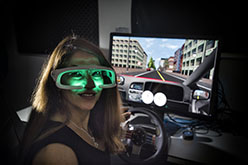
Caffeine and blue-green light have significant effects on improving the driving performance of chronically sleep deprived young people, an innovative QUT study has found.
Shamsi Shekari, from QUT’s Centre for Accident Research & Road Safety - Queensland (CARRS-Q), tested the use of blue-green light and caffeine on young drivers aged 18-25 in a driving simulator to see if it increased alertness during daytime driving.
“Driver sleepiness accounts for 20 per cent of all crashes in developed countries, and young drivers are at an increased risk of chronic sleep deprivation,” she said.
Watch Mrs Shekari explain her research
“This is due to later brain development and social factors such as friends, work patterns and increased use of drugs and alcohol, all of which impact on sleep.”
 Mrs Shekari said the study tested the novel and potentially effective use of bright light, using commercially available light glasses that emit a shortwave blue-green light, and caffeinated chewing gum on driver sleepiness.
Mrs Shekari said the study tested the novel and potentially effective use of bright light, using commercially available light glasses that emit a shortwave blue-green light, and caffeinated chewing gum on driver sleepiness.
She said light therapy was being used to adjust a person’s circadian rhythm in shift workers and pilots and offered the potential to reduce sleepiness.
“The two-week study included monitoring sleep-wake patterns, with a normal eight hours of time in bed in the first week being reduced by to seven hours in the second week to produce chronic sleep deprivation in the participants,” she said.
“On the last three days participants took test sessions which involved recording their brain and heart activity, reaction times, assessment of their sleepiness and two 50km-long simulated drives each day.
“To compare the effectiveness of the countermeasures, all participants were provided with inactive chewing gum and light in the first drive and randomized active chewing gum and light in the second drive.”
Mrs Shekari said there was a significant effect on driving performance, mostly when caffeine was used alone or combined with light.
“Drivers who were given just caffeine, or light and caffeine together had decreased side to side movement of the steering wheel and the vehicle, indicating better control of the vehicle and higher alertness,” she said.
“Drivers who were feeling some signs of sleepiness after sleep loss, felt less sleepy after receiving either light or caffeine, and even felt rather alert after receiving the combination of light and caffeine.
“However, there was a discrepancy between feelings of sleepiness and actual driving performance.
“This is a big concern given current advertising messages rely on drivers making their own judgement of when they are too sleepy to drive.”
Mrs Shekari said while her study had revealed promising results of the use of light and caffeine to improve driver alertness, more research was needed.
“CARRS-Q is now undertaking a study on the effect of sleep loss and caffeine on driving where we want to learn about more specifically about the effect of daytime sleepiness and caffeine on driver performance,” she said.
To find out more or take part in the study, visit http://www.carrsq.qut.edu.au/caffeine/index.jsp
Media contacts:
Sandra Hutchinson, QUT media officer, 07 3138 9449 (Tue/Wed) or media@qut.edu.au
Rose Trapnell, QUT media team leader, 07 3138 2361 or 0407 585 901


